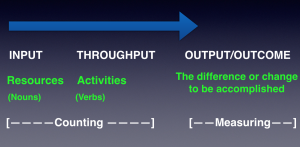Our District Superintendent, Kendall Waller, recently asked the pastors of the Heartland District to enter into conversation about Gil Rendle’s new book. In his book, “Doing the Math of Mission“, Gil Rendle proposes radically changing the way in which we count/measure ministry in the United Methodist Church. Up to now, much of our focus for defining fruitfulness and effectiveness of churches has been based on the ABC’s of ministry (attendance, buildings, cash). These numbers as they all increase are lifted up as a standard of vitality. Meaning, that when a United Methodist attends Annual Conference, the featured speakers are either Mega-Church pastors or “fast growing” church pastors. This is not the norm for all, other speakers are invited as well (Professors, Authors, Bishops). Just because a church is big doesn’t mean it’s healthy or impactful.
The formula for determining a new way of counting/measuring is as follows:
Inputs– attendance, buildings, cash, assets, resources, numbers
Activities– what we do
Output/Outcome– Goals achieved, Desired Change, Vision realized
The differences between counting/measuring are not easily defined unless you read the book.
“Counting is giving attention to numbers.”
“Measuring is giving attention to change.”
We are asked to report our inputs/resources/numbers on our year end reports, and weekly. Those are things we can count. Moving from counting to measuring means walking into uncharted territory because measuring is not easy. If you we look at the membership vows of the United Methodist Church-
Prayers, Presence, Gifts, Service, Witness
We can count presence and gifts, possibly service if you track such things. But how do we count prayers or witness? Yes, it can be self reported, but again, the focus is on counting, not measuring.
If we give attention to numbers, we are focusing on getting more numbers, which many know, just showing up in a movie theater does not make you a movie star. Hanging out in a garage will not make you a mechanic unless you actually take up the trade. More does not always mean better, as Willow Creek realized in their Reveal study.
So then, what would it look like if we attempted to shift from an asset based focus to life transformation focus?
Yes, many churches and pastors will honestly state that we focus on life change and transformation, but again, what are we counting and what are we focused on?
A few questions arise in conversing with the book-
1. Do all of the ministry in our local church make a significant difference in the lives of those served?
2. Does the church impact the people and culture in the name of Jesus?
3. Are we seeking to fill the building or fill the Kingdom?
4. Do people know us for what we are against or what we are for?
5. As the Body of Christ and individual followers of Christ, what are we giving away?
Personally, it has caused me to reassess how and why we are doing some things in the church. Even though our ABC’s are extraordinary right now, are we focused on the right things? Do all our ministries align to achieve our stated purpose and goals?
If our stated goal is to make disciples of Jesus Christ for the transformation of the world, how are we doing? Do people know and experience the transformational power of Jesus Christ in their lives? What role does the UMC play?
Here’s the thing, I do not have many answers or brilliant ideas from the book. As of now, praying and pondering how we might live our faith out differently if we changed our metrics. It’s an interesting and thought provoking tectonic shift for the UMC, and other churches.
Our district is working on a few “big” impact projects for all the churches to participate in. These are going to be seismic transformational projects that will deeply impact the Kansas City population. As we shift our focus in the local church and district, I am hopeful other districts, churches and conferences will follow. No matter what some say, it’s an exciting and fruitful time to be serving in the United Methodist Church, especially in the Missouri Conference.
Go in peace and go with God.

